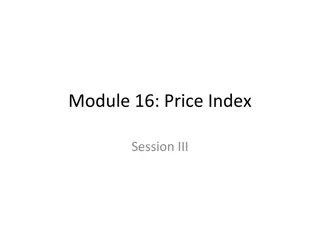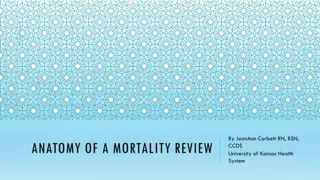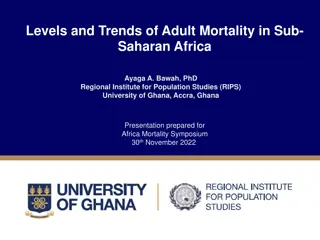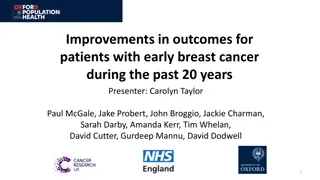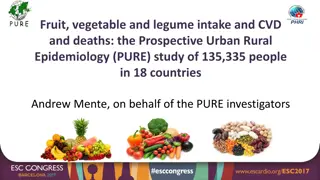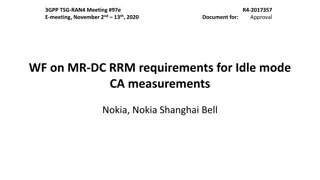Mortality Aggregation Examples at NAIC National Meeting
In August 2019, key concepts for mortality aggregation were discussed at the NAIC National Meeting. The examples presented covered approaches under VM-20 language, emphasizing the importance of informed mortality segment assumptions through credible aggregation methods.
Download Presentation

Please find below an Image/Link to download the presentation.
The content on the website is provided AS IS for your information and personal use only. It may not be sold, licensed, or shared on other websites without obtaining consent from the author.If you encounter any issues during the download, it is possible that the publisher has removed the file from their server.
You are allowed to download the files provided on this website for personal or commercial use, subject to the condition that they are used lawfully. All files are the property of their respective owners.
The content on the website is provided AS IS for your information and personal use only. It may not be sold, licensed, or shared on other websites without obtaining consent from the author.
E N D
Presentation Transcript
August 2019 1 Mortality Aggregation Examples NAIC National Meeting Summer 2019 Rachel Hemphill, MAAA, FSA, FCAS Pat Allison, MAAA, FSA
August 2019 2 Agenda Key Concepts and Applicable VM-20 Language Examples and Comparison of Approaches Next Steps
August 2019 3 Key Concepts for Mortality Aggregation Mortality segments subject to the same or similar underwriting processes may be aggregated to calculate credibility Using separate mortality segment experience to set each corresponding assumption and then simply grouping the segments together to calculate credibility is not mortality aggregation under VM-20 The aggregate experience must inform the mortality segment assumptions; two approaches are allowed under VM-20
August 2019 4 Applicable VM-20 Language VM-20 Section 9.C.2.d vi. If the company uses the aggregate company experience for a group of mortality segments when determining the company experience mortality rates for each of the individual mortality segments in the group, the company shall either: a. Use techniques to further subdivide the aggregate experience into the various mortality segments (e.g., start with aggregate non- smoker then use the conservation of total deaths principle, normalization or other approach to divide the aggregate mortality into super preferred, preferred and residual standard non-smoker class assumptions), or b. Use techniques to adjust the experience of each mortality segment in the group to reflect the aggregate company experience for the group (e.g. by credibility weighting the individual mortality segment experience with the aggregate company experience for the group). Top Down Approach Bottom Up Approach
August 2019 5 Disclaimer: The examples presented are for illustrative purposes to demonstrate acceptable approaches. They are not intended to cover all complexities that may arise in practice. Additional variations and other methods may be appropriate. These examples are intended to illustrate general principles, not to be an exhaustive presentation of acceptable methods. Mortality Aggregation Examples
August 2019 6 Approach: Bottom Up Mortality Aggregation Example Level of Aggregation: All Segments
August 2019 7 Identify Segments for Aggregation (1) (2) Groups of Policies Segment Description Segment 1 MNS Ultra Preferred Segment 2 MNS Super Preferred Segment 3 MNS Preferred Segment 4 MNS Standard Segment 5 MSM Preferred Segment 6 MSM Standard Segment 7 FNS Ultra Preferred Segment 8 FNS Super Preferred Segment 9 FNS Preferred Segment 10 FNS Standard Segment 11 FSM Preferred Segment 12 FSM Standard Aggregate All Segments Combined
August 2019 8 Calculate Expected Claims and A/E Ratios (1) (3) (4) (5) (6) Groups of Policies Segment 1 Segment 2 Segment 3 Segment 4 Segment 5 Segment 6 Segment 7 Segment 8 Segment 9 Segment 10 Segment 11 Segment 12 Mortality Tables: 2015 VBT ALB MNS RR 70 MNS RR 80 MNS RR 90 MNS RR 110 MSM RR 75 MSM RR 125 FNS RR 70 FNS RR 80 FNS RR 90 FNS RR 110 FSM RR 75 FSM RR 125 Expected Claim Amounts Using (3) 64 343 510 617 800 833 32 226 445 545 733 756 Actual Claim Amounts 50 300 400 500 600 700 25 200 350 450 550 650 A/E 78.1% 87.5% 78.4% 81.0% 75.0% 84.0% 78.1% 88.5% 78.7% 82.6% 75.0% 86.0% Aggregate 5904 4775 80.9%
August 2019 9 Calculate Credibility and Credibility- Weighted (CW) A/E (1) (7) (8) (9) (10) (11) Groups of Policies Segment 1 Segment 2 Segment 3 Segment 4 Segment 5 Segment 6 Segment 7 Segment 8 Segment 9 Segment 10 Segment 11 Segment 12 Aggregate Credibility Complement * 85% 38% 22% 11% 5% 0% 95% 67% 34% 25% 8% 2% Aggregate A/E 80.9% 80.9% 80.9% 80.9% 80.9% 80.9% 80.9% 80.9% 80.9% 80.9% 80.9% 80.9% Credibility * 15% 62% 78% 89% 95% 100% 5% 33% 66% 75% 92% 98% 100% A/E + = CW A/E = 80.5% = 85.0% = 79.0% = 81.0% = 75.3% = 84.0% = 80.7% = 83.4% = 79.4% = 82.1% = 75.5% = 85.9% * 78.1% + * 87.5% + * 78.4% + * 81.0% + * 75.0% + * 84.0% + * 78.1% + * 88.5% + * 78.7% + * 82.6% + * 75.0% + * 86.0% + * * * * * * * * * * * *
August 2019 10 Perform Calculations to Maintain Conservation of Deaths (1) (4) (5) (11) (12) (13) (14) Col(4)*Col(11) CW Expected Claim Amounts 51 291 403 500 602 700 26 188 353 448 553 649 4766 1.001905 Col(11)*NR Col(4)*Col(13) Normalized Expected Claim Amounts 52 292 404 501 603 701 26 189 354 449 554 650 4775 Expected Claim Amounts 64 343 510 617 800 833 32 226 445 545 733 756 5904 Actual Claim Amounts CW A/E 50 300 400 500 600 700 25 200 350 450 550 650 4775 Groups of Policies Segment 1 Segment 2 Segment 3 Segment 4 Segment 5 Segment 6 Segment 7 Segment 8 Segment 9 Segment 10 Segment 11 Segment 12 Aggregate Normalization Ratio (NR) = 4775 / 4766: Normalized CW A/E 80.6% 85.1% 79.1% 81.2% 75.4% 84.2% 80.9% 83.6% 79.6% 82.3% 75.6% 86.0% 80.5% 85.0% 79.0% 81.0% 75.3% 84.0% 80.7% 83.4% 79.4% 82.1% 75.5% 85.9%
11 Set the Assumption for Company Experience Mortality Rates (1) (3) (13) (15) Groups of Policies Segment 1 Segment 2 Segment 3 Segment 4 Segment 5 Segment 6 Segment 7 Segment 8 Segment 9 Segment 10 FNS RR 110 Segment 11 FSM RR 75 Segment 12 FSM RR 125 Mortality Tables: 2015 VBT ALB MNS RR 70 MNS RR 80 MNS RR 90 MNS RR 110 MSM RR 75 MSM RR 125 FNS RR 70 FNS RR 80 FNS RR 90 Normalized CW A/E 80.6% 85.1% 79.1% 81.2% 75.4% 84.2% 80.9% 83.6% 79.6% 82.3% 75.6% 86.0% Company Experience Mortality Rates 80.6% of 2015 VBT MNS RR 70 ALB 85.1% of 2015 VBT MNS RR 80 ALB 79.1% of 2015 VBT MNS RR 90 ALB 81.2% of 2015 VBT MNS RR 110 ALB 75.4% of 2015 VBT MSM RR 75 ALB 84.2% of 2015 VBT MSM RR 125 ALB 80.9% of 2015 VBT FNS RR 70 ALB 83.6% of 2015 VBT FNS RR 80 ALB 79.6% of 2015 VBT FNS RR 90 ALB 82.3% of 2015 VBT FNS RR 110 ALB 75.6% of 2015 VBT FSM RR 75 ALB 86.0% of 2015 VBT FSM RR 125 ALB
August 2019 12 Applicable VM-20 Language VM-20 Section 9.C.2.d vi. If the company uses the aggregate company experience for a group of mortality segments when determining the company experience mortality rates for each of the individual mortality segments in the group, the company shall either: a. Use techniques to further subdivide the aggregate experience into the various mortality segments (e.g., start with aggregate non- smoker then use the conservation of total deaths principle, normalization or other approach to divide the aggregate mortality into super preferred, preferred and residual standard non-smoker class assumptions), or b. Use techniques to adjust the experience of each mortality segment in the group to reflect the aggregate company experience for the group (e.g. by credibility weighting the individual mortality segment experience with the aggregate company experience for the group). Top Down Approach Bottom Up Approach
August 2019 13 Approach: Top Down Mortality Aggregation Example 2 Levels of Aggregation: Smoker Segments, Non-Smoker Segments
August 2019 14 Identify Segments for Aggregation (1) (2) Groups of Policies Segment Description Segment 1 MNS Ultra Preferred Segment 2 MNS Super Preferred Segment 3 MNS Preferred Segment 4 MNS Standard Segment 5 MSM Preferred Segment 6 MSM Standard Segment 7 FNS Ultra Preferred Segment 8 FNS Super Preferred Segment 9 FNS Preferred Segment 10 FNS Standard Segment 11 FSM Preferred Segment 12 FSM Standard Aggregate NS All Non-Smoker Segments Combined Aggregate SM All Smoker Segments Combined
August 2019 15 Calculate Relativity Structure (here based on RR Tool output) (1) (3) (4) (5) (6) Groups of Policies Segment 1 Segment 2 Segment 3 Segment 4 Segment 5 Segment 6 Segment 7 Segment 8 Segment 9 Segment 10 Segment 11 Segment 12 Aggregate NS Aggregate SM Mortality Tables: 2015 VBT ALB MNS RR 70 MNS RR 80 MNS RR 90 MNS RR 110 MSM RR 100 MSM RR 125 FNS RR 70 FNS RR 80 FNS RR 90 FNS RR 110 FSM RR 100 FSM RR 150 Expected Claim Amounts Using (3) 200 484 533 582 525 833 175 335 425 542 490 725 3276 2573 Aggregate Non-Smoker Credibility: Aggregate Smoker Credibility: Actual Claim Amounts 187 495 520 563 545 850 182 320 384 531 500 745 3182 2640 100% 85% A/E 93.5% 102.3% 97.6% 96.7% 103.8% 102.0% 104.0% 95.5% 90.4% 98.0% 102.0% 102.8% 97.1% 102.6%
August 2019 16 Set the Assumption for the Company Experience Mortality Rates (1) (3) (7) (8) (9) Groups of Policies Segment 1 Segment 2 Segment 3 Segment 4 Segment 5 Segment 6 Segment 7 Segment 8 Segment 9 Segment 10 FNS RR 110 Segment 11 FSM RR 100 Segment 12 FSM RR 150 Mortality Tables: 2015 VBT ALB MNS RR 70 MNS RR 80 MNS RR 90 MNS RR 110 MSM RR 100 MSM RR 125 FNS RR 70 FNS RR 80 FNS RR 90 Aggregation Level Non-Smoker Non-Smoker Non-Smoker Non-Smoker Smoker Smoker Non-Smoker Non-Smoker Non-Smoker Non-Smoker Smoker Smoker Aggregate A/E 97.1% 97.1% 97.1% 97.1% 102.6% 102.6% 97.1% 97.1% 97.1% 97.1% 102.6% 102.6% Company Experience Mortality Rates 97.1% of 2015 VBT MNS RR 70 ALB 97.1% of 2015 VBT MNS RR 80 ALB 97.1% of 2015 VBT MNS RR 90 ALB 97.1% of 2015 VBT MNS RR 110 ALB 102.6% of 2015 VBT MSM RR 100 ALB 102.6% of 2015 VBT MSM RR 125 ALB 97.1% of 2015 VBT FNS RR 70 ALB 97.1% of 2015 VBT FNS RR 80 ALB 97.1% of 2015 VBT FNS RR 90 ALB 97.1% of 2015 VBT FNS RR 110 ALB 102.6% of 2015 VBT FSM RR 100 ALB 102.6% of 2015 VBT FSM RR 150 ALB
August 2019 17 Comparison of Approaches "Top Down Example "Bottom Up Example Uses credibility weighting to adjust the experience of each mortality segment to reflect the aggregate experience. Methodology Uses relativities to subdivide the aggregate experience into mortality segments. Source of experience data Uses a company experience study A/E for the aggregate class(es), along with pre- defined expected relativities between mortality segments determined from a reliable and applicable external source. Uses company experience study A/E and credibility results for all individual mortality segments and for the aggregate class.
August 2019 18 Comparison of Approaches "Top Down Example The aggregate class A/E ratios(s) and aggregate credibility must be updated based on each new company experience study. The relativities would not change unless the external source (e.g. RR Tool, reinsurer) indicates that relationships between segments have changed or the external source data is no longer representative of the company experience. "Bottom Up Example The aggregate class and individual mortality segment credibilities and A/E ratios must be updated based on each new company experience study. Updates based on new experience studies
August 2019 19 Comparison of Approaches "Top Down Example "Bottom Up Example Conservation of deaths Conservation of deaths is maintained using the normalization process, such that the total amount of expected claims is not less than the aggregate. Prudent estimate assumptions Anticipated experience assumptions are likely to be different by approach, but prescribed margins would be the same if the same level of aggregation is used to determine credibility.
August 2019 20 Other examples have been developed. See Excel spreadsheet. Mortality Aggregation Examples
August 2019 21 Next Steps Consider exposing examples for public comment Review comments and revise accordingly Post examples to the Industry Tab on the NAIC website









